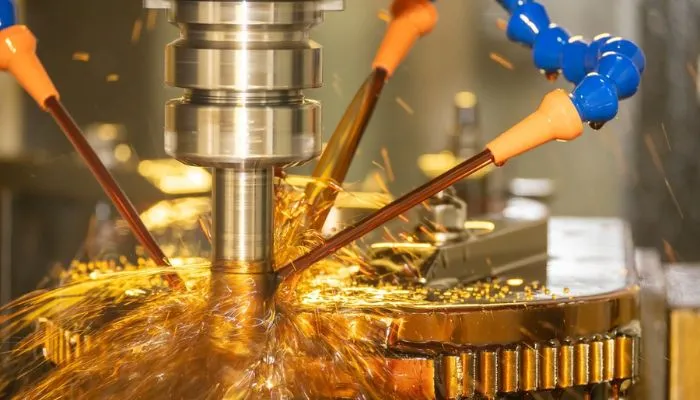Hello, friends today’ we are talking to “Indexing in Milling Machine” in which you will learn what is indexing in milling machines, types of indexing heads, different indexing methods as well as their formula and calculation.
What is Indexing in Milling Machine?

Milling machines are invaluable tools in the world of manufacturing, enabling the production of intricate components used in various industries. One of the key techniques employed in milling operations is indexing, a method used to rotate the workpiece or cutting tool precisely. Understanding the nuances of indexing, including the milling machine head, parts involved, methods, and calculations, is essential for machinists and engineers striving for accuracy and efficiency in their work.
Milling Machine Head
At the heart of every milling machine lies its head, a crucial component responsible for the machine’s precision and power. Milling machine heads come in various types, including vertical and horizontal heads, each serving specific purposes. The head houses the spindle, motor, and other critical mechanisms, providing the necessary force and control for milling operations. Choosing the right type of head ensures that the machine can handle a diverse range of tasks with optimal efficiency.
Read also: Types of Cutting Tool Materials and Their Properties
Parts Involved in Indexing
- Indexing Head: The indexing head is an attachment used to hold and rotate the workpiece accurately. It plays a pivotal role in dividing circles and angles precisely, enabling complex milling operations. The indexing head allows for the creation of equally spaced divisions on the workpiece, a fundamental requirement for many machining tasks.
- Dividing Plates: Dividing plates are circular plates with an array of holes arranged in specific patterns. Mounted on the indexing head, these plates facilitate the division of the workpiece into equal parts. The selection of the appropriate dividing plate is critical as it determines the number of divisions achievable on the workpiece.
- Indexing Gears: Indexing gears are essential components used to transmit motion from the milling machine’s motor to the dividing plates. Proper selection of these gears is vital to achieve the desired indexing ratio. By choosing the right combination of gears, machinists can ensure precise rotation of the workpiece, leading to accurate machining results.
Methods of Indexing
- Direct Indexing: Direct indexing involves using the divisions present on the indexing head to rotate the workpiece directly. This method is suitable for simple tasks that require straightforward divisions. Machinists can achieve precise angular increments by aligning the workpiece with the appropriate divisions on the indexing head.
- Simple Indexing: Simple indexing employs a dividing plate with a specific number of holes to rotate the workpiece a predetermined number of degrees. This method is ideal for dividing circles into equal parts and is commonly used in tasks where accuracy and consistency are paramount. By selecting the right combination of dividing plates and indexing gears, machinists can achieve the desired divisions on the workpiece.
- Compound Indexing: Compound indexing involves combining two or more simple or direct indexing operations to create intricate divisions on the workpiece. This method is valuable for tasks that demand complex angular divisions and enables machinists to produce intricate components with high precision. By carefully planning the sequence of indexing operations, machinists can achieve intricate geometries on the workpiece.
Calculation in Indexing
- Calculation of Indexing Plates: Selecting the appropriate dividing plate requires careful calculation of the number of holes needed to achieve the desired division. Machinists must consider the indexing ratio, which determines the relationship between the rotations of the dividing plate and the workpiece. By understanding this ratio, machinists can choose the right dividing plate to achieve the desired divisions accurately.
- Gear Ratio Calculation: Determining the gear ratio is a critical aspect of indexing calculations. The gear ratio is calculated based on the number of holes on the dividing plate and the teeth of the indexing gears. Machinists must calculate the gear ratio accurately to ensure that the indexing head rotates the workpiece precisely. By selecting the appropriate gears and understanding the gear ratio, machinists can achieve accurate indexing and produce high-quality components.
In conclusion, indexing in milling machine operations is a sophisticated technique that requires a deep understanding of milling machine heads, components, methods, and calculations. By mastering the art of indexing, machinists and engineers can elevate the quality of their work, producing intricate components with exceptional accuracy.
Read also: Are PET Bottles Safe for us and the environment?
Whether dividing circles into equal parts or creating complex geometric shapes, the knowledge of indexing is indispensable for professionals in the field of machining. As technology advances, the mastery of these fundamental techniques continues to be a cornerstone of precision engineering, ensuring the production of high-quality components that drive various industries forward.
Read also: How Tight Should an Oil Filter Be?
In this discussion, we explored the concept of indexing in milling machines, delving into the various types of indexing heads and the diverse methods employed in the process. Additionally, we examined the formulas and calculations associated with these indexing techniques.
I trust you found this information valuable.
Thank you.
